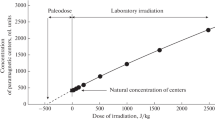Abstract
Dating of samples of cave dripstones collected from the Jaskinia Czarna (the Polish Tatra Mountains) and fossil bones was carried out by means of electron paramagnetic resonance (EPR). By this method the age of the sample is found as the ratio of the total dose (TD) to the annual dose rate (D a). TD is established on the basis of EPR spectra, whileD a is the sum of the internal dose rate, calculated on the basis of the concentration and activity of radioactive nuclides in the sample, and the external dose rate measured at the site of the sample collection by a calibrated γ-radiation probe. Two models of uranium accumulation were used: the model of linear accumulation and the model on the basis of the assumption of a disturbed radiation equilibrium in the uranium series. The results were compared with the age determined by the uranium-thorium method. Moreover, by the computer resolution enhancement method the dynamics of paramagnetic centers in calcite annealed in nitrogen atmosphere was studied in the range of 283–873 K, and the results were compared with earlier results for calcite annealed in the air. On the basis of the study of paramagnetic center dynamics in dripstone calcite it was established that the radicals responsible for the EPR signals were CO −2 in different symmetries of the crystalline field, CO 3−3 in the axial symmetry, CO −3 in the axial and isotropic symmetry and HCO 2−3 . The results implied that samples to be subjected to EPR dating should be kept at room temperature.
Similar content being viewed by others
References
Smart P.L., Frances P.D.: Quaternary Dating Methods — A User’s Guide, Technical Guide no. 4, p. 112. Cambridge: Quaternary Research Association 1991.
Ikeya M.: Jpn. J. Appl. Phys.21, L690-L692 (1982)
Hercman H.: Politechnika Śląska — Zeszyty Naukowe, no. 1080, 20–21 (1991)
Gordy W.: Theory and Applications of Electron Spin Resonance. New York: Wiley 1979.
Krzyminiewski R., Kowalczyk R.M., Bielewicz-Mordalska A., Pająk Z., Czarnecki P.: J. Mol. Struct.471, 234–249 (1998)
Hedberg A., Ehrenberg A.: J. Chem. Phys.48, 4822 (1968)
Koper A., Krzyminiewski R.: Acta Magn.II, 3 (1985)
Madisetti V.K., Williams D.B. (eds.): The Digital Signal Processing Handbook. New York: CRC/IEEE Press 1998.
Krzyminiewski R., Frąckowiak M.: Mol. Phys. Rep.28, 89–100 (2000)
Blackwell B.A.: Quat. Sci. Rev.13, 651–660 (1994)
Cetin O., Özer A.M., Wiesert A.: Quat. Sci. Rev.13, 661–669 (1994)
Desrosiers M., Schauer D.A.: Nucl. Instrum. Methods Phys. Res. B184, 219–228 (2001)
Ikeya M., Miki T.: Acta Carsol.XI, 121–130 (1982)
Wieser A., Göksu H.Y., Regulla D.F., Vogenauer A.: Quat. Sci. Rev.7, 491–495 (1988)
Gaigalas A., Molodkov A.: Geochronometria21, 57–64 (2002)
Debuyst R., Bidiamambu M., Dejehet F.: Nucl. Track Radiat. Meas.18, 193–201 (1991)
Duliu O.G.: Appl. Rad. Isotopes52, 385–1390 (2000)
Dash J.K., Balakrishnan S., Rao P.S.: Adv. ESR Appl.18, 41–46 (2002)
Landolt-Börstein: Magnetic Properties of Free Radicals, Part a: Atoms, Inorganic Radicals and Radicals in Metal Complexes (Daul C., Fisher H., Morton F.H., Preston K.F., Zelewsky A.V., eds.), group 2, vol. 9. Berlin: Springer 1977.
Marshall S.A., McMillan J.A., Serway R.A.: J. Chem. Phys.48, 5131–5137 (1968)
Serway R.A., Marshall S.A.: J. Chem. Phys.46, 1949–1952 (1967)
Kai A., Miki T., Ikeya M.: Quat. Sci. Rev.7, 503–507 (1988)
Noething-Laslo V., Brečević L.: Phys. Chem. Chem. Phys.2, 5328–5332 (2000)
Moens P.D.W., Callens F.J., Verbeeck R.M.H., Naessens D.E.: Appl. Radiat. Isot.44, 279–285 (1993)
Author information
Authors and Affiliations
Corresponding author
Rights and permissions
About this article
Cite this article
Wencka, M., Krzyminiewski, R. Identification of paramagnetic centers and the dating of cave dripstones by electron paramagnetic resonance. Appl. Magn. Reson. 26, 561–578 (2004). https://doi.org/10.1007/BF03166583
Received:
Revised:
Issue Date:
DOI: https://doi.org/10.1007/BF03166583




